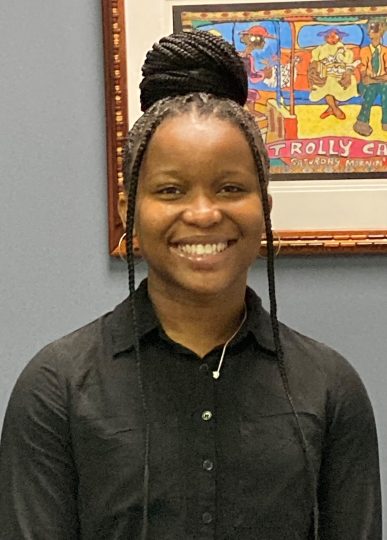A Future Social Studies Teacher Reflects: The Importance of Youth Civic Engagement on Election Day – And Especially All the Days That Follow
By Daisha Williams, youth contributor & University of Dayton undergraduate | November 11, 2022
 Being a Student-Teacher, I am required to spend hundreds of hours in a classroom teaching students and proving to the state that I am a capable teacher candidate, knowledgeable in my content area, and able to manage a classroom of 7-12th graders with the skills needed to differentiate the lesson and appeal to every student, no matter their needs.
Being a Student-Teacher, I am required to spend hundreds of hours in a classroom teaching students and proving to the state that I am a capable teacher candidate, knowledgeable in my content area, and able to manage a classroom of 7-12th graders with the skills needed to differentiate the lesson and appeal to every student, no matter their needs.
As an undergraduate at the University of Dayton, I am specializing in Social Studies education with a minor in Political Science. I believe that the sooner we introduce students to the ideas of federalism, the unalienable rights guaranteed in our Bill of Rights, and even the process of voting, the better off we all are, especially our students who can gain the skills necessary to be informed and engaged voters. This begins the work of being civically engaged.
During my time as Youth Forum Ambassador and CDF-Ohio Consultant, I have had the opportunity to contribute to this Youth Blog and write about the political power Gen-Z possesses, how voting rights are once again under scrutiny making activists and public figures stand up for a call to reclaim these rights, and the initiatives taking place in Ohio and nationally to increase civic engagement. As my last blog in this series, I want to end it right.
We end with a call to action. We end it hoping that Gen-Z knows their power and how they can exercise their voices through the elections process. To call on young adults to simply show up to the polls is only one action of many to take when discussing civic engagement. Young adults and youth can and should be active in their democracies on election day and throughout the days that follow.
One action that has been used since late in the 19th century transitioning to the 20th is calling your representative. A year following the patent of the telephone, President Hayes had a telephone installed in the White House. Over time, this became a tool where hundreds to thousands of constituents would call their Congress representative or governor to tell them their concerns. This action can be effective, slowing up the process in political buildings, giving staff no choice but to pay attention to the concerns of the people. It is not as disruptive as being in the streets and organizing a march, but it is still a way to exercise the rights to petition the government. This can lobby politicians and political representatives to vote against or for a bill in the best interest of what the voters need at that moment. Not only is calling available, but with the 21st century technology, you can send an email to your representative or political official, send a forum on the government website, and take it back to writing letters to your representative. This is your government; tell them what you want to see from it. The American Civil Liberties Union provides a guide for its readers and supporters informing them on their rights when participating and organizing demonstrations and protests.
Another way to engage civically is attending town halls and hearings for bills that affect you or a loved one. Providing testimony and speaking before the committees that vote, create, and modify bills that affect your livelihood is a way to participate in civic engagement. It is a way to talk about how the bills that are being voted on and passed affect you. For example, discussing how bills that restrict or increase access to healthcare can affect someone in your life with a compromised immune system. Giving testimony at hearings can help provide state committees insight as to what a bill will do to those who are affected the most – the people.
Another way that young adults can engage in civics can happen in their interactions with their friends or colleagues. Talking to your peers about issues that affect you all can help people get engaged, gain insight on issues, and be an informed voters so you can vote strategically. One problem that is facing politics is the extreme polarization. In politics now, it can feel like you have to belong to a specific side and believe that the other side is your enemy, rather than someone who has opposing beliefs than you about how to solve issues taking place in America. The New York Times reports how many more Americans feel negatively about people of another political party than people of different religions or races. Young adults can combat this by paying attention to solutions rather than what a party believes or wants. Taking time to listen to the other side and agreeing to disagree are productive and meaningful ways to engage in civil discourse with someone with different political beliefs. Coming to a common ground and knowing when to end a conversation helps not only keep friendships among other party members but also to decrease the polarization in politics that further divides us.
No matter which route one takes to being actively engaged in politics, voting is always a necessary and reasonable first step to participating and being engaged in civic duties. To vote strategically, to encourage peers, family members, and community members to vote increases our numbers, which is absolutely needed in all levels of government. A study conducted by the Abdul Latif Jameel Poverty Action Lab, adding social pressure to registered voters to participate in the election increased voter turnout by 29%. A 2012 study showed that using the ‘I Voted’ sticker on your Facebook profile page increased the amount of people that voted. Creating your own ballot based on what your interests are and what candidate embodies those interests is a way to also help conceive of your government as a group of individuals that solves society’s problems in the ways you think they can and should be solved.
Finally, to receive a proper education on civics, government, and participation in government is important. Providing young voters and our youth who should be knowledgeable about voting a voter guide like the Kids Voting Ohio Voter Guide not only gives youth options for candidates but information regarding what a midterm election is, the different ways to vote, and information on issues like Issue 1 that calls for bail amounts to be based on public safety.
As a future social studies teacher, I am inspired by the challenge to lay the groundwork for middle and high school students about what it means to civically engaged to inform students on how we protect our rights, and teach how our Founding Fathers, our ancestors, our grandparents, and all those who came before us ensured that we would have a say in our government and how our nation is governed. There was a point in time where we as people could not vote unless we were white, male landowners. Through compromises, recreating our system of government, amendments, acts, national initiatives, and unrest, we demanded justice. We can continue the work of those who came before us by not only empowering our youth but also by empowering those around us, no matter what sides of the partisan aisle we land. To empower our youth is to empower another generation to make better decisions and to make a better state and nation. We stand on the shoulders of giants and they will, too, one day. Let’s ensure every generation that follows takes up the helm to continue the critical work of building and raising democracy of those before them.
CDF-Ohio thanks Daisha Williams for raising her voice about the importance of youth engagement in democracy and for high quality civic education in our schools throughout this youth contributed blog series. Read Daisha’s previous contributions to the CDF-Ohio Youth Blog:

